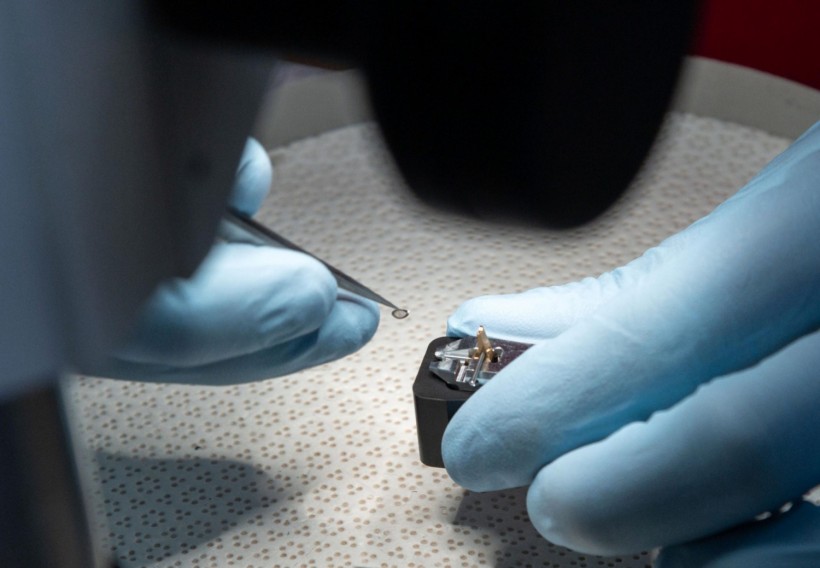The Japanese Hayabusa 2 spacecraft visited the asteroid Ryugu from 2018 to 2019. They returned rock samples that contained gases that are shedding light on the formation of the asteroid and other solar system objects.
Before the giant planets' movement threw Ryugu toward Earth, it was likely formed near the outer reaches of our solar system. New Scientist said these materials could provide light on the past of the outer solar system since a recent examination of the iron in the samples suggests that it may have come from even further out than previously thought, possibly from close to Uranus and Neptune.
Japan's Hayabusa 2's Data Show That Asteroid Ryugu Was Once a Meteorite
By carefully examining the ratios of isotopes or the same elements with varying numbers of neutrons and weights, scientists can determine the environment and time in which a rock was produced.
The Ryugu samples that Japan's Hayabusa 2 got resembled an uncommon class of meteorites called Ivuna-type carbonaceous chondrites. The rocks' isotopic fingerprints reveal the location and period of their formation.
According to Nicolas Dauphas from the University of Chicago, coauthor of the study published in the October 20th Science Advances, the fragile nature of the primordial material discovered on Ryugu makes it uncommon on the ground.
Researchers said the extremely "friable and fragile" CI-type meteorites would have either been eradicated in the atmosphere or not been identified as meteorites on the ground because moisture transforms them into unidentifiable mud.

NASA recently received its first sample of asteroid Ryugu, which was returned to Earth last December by the Japan Aerospace Exploration Agency’s (JAXA) Hayabusa2 spacecraft. This is one of the first samples to leave Japan for preliminary investigation. As deputy leader of the mineralogy-petrology subteam for the preliminary analysis effort, Mike Zolensky was one of the first scientists to examine the sample to determine its basic nature. Alongside Zolensky, Jangmi Han from the Astromaterials Research and Exploration Science Division and James Martinez of the Structural Engineering Division at NASA’s Johnson Space Center in Houston worked together to complete an investigation of the sample. Sample analyses were performed in the Scanning Electron Microscopy Lab in Johnson’s Structural Engineering Division. This was completed within five days. Zolensky is one of a hundred of investigators worldwide to receive a sample from JAXA. Preliminary sample analyses are continuing at Johnson. Studying carbonaceous asteroids like Ryugu could help scientists understand how the solar system formed.
The isotopic signature of CI carbonaceous chondrites is possibly much older than that of the primordial solar nebula that gave rise to the planets. The abundance and isotopic makeup of nitrogen and noble gases in the Ryugu sample were examined in a separate study. The results were reported in Science on October 20th.
The project's leader, Ryuji Okazaki of Kyushu University, Japan, claims that the samples from the asteroid show exceedingly primitive material, similar to that which might be found between stars outside the solar nebula.
According to their isotopic signatures, unusually high percentages of the grains contained gases that had been transported to interstellar space after forming around red giants or in supernovae.
The investigation also revealed gaseous isotopes created by solar wind bombardment and cosmic ray radiation. Okazaki's team deduces from this data that Ryugu's considerably bigger parent body originated in the outer solar system.
After a collision broke the parent body, some of the original components re-accumulated into what is now Ryugu. The main asteroid belt is where the asteroid spent some time and is where galactic cosmic rays made their mark. The asteroid started moving into its present near-Earth orbit around 3 to 8 million years ago, where it began gathering additional solar wind material.
Where It Originated
Scientists believe that during the formation of the solar system, Jupiter and Saturn's gravitational interactions with the protoplanetary disk caused the material to be gravitationally distributed in two directions: inward for non-carbonaceous chondrites and outward for carbonaceous chondrites.
There was no need for a third group before Ryugu, despite some people's suspicions that it may exist and contain primitive stuff from the outer solar system. With the discovery of the isotopic signature of primordial material in the solid portion of the Ryugu samples, Dauphas said (per Sky and Telescope), "You can say there clearly is another group."
Dauphas hypothesizes that the third group was created distant from the Sun as debris was blasted out of the orbits of the ice giants Uranus and Neptune. Although this group would have stayed outside the main asteroid belt, some items moved inside to the Oort cloud while others went outward to the cloud.
More delicate than material closer to the Sun, the third group's material remained further from the Sun than that which was dispersed inward from Jupiter and Saturn. As a result, it was less likely to survive impact with Earth as a meteorite. As a result, asteroids would have CI chondrites far more frequently than meteorites. As a result, asteroids are perhaps the solar system's most easily available supply of the most primitive material.
RELATED ARTICLE: Japan's Martian Moons eXploration (MMX) Aims to Take Home Samples From Martian Moon Phobos
Check out more news and information on Space in Science Times.


![Some Brain-Injured Patients Who Died After Life Support Was Withdrawn May Have Survived, Recovered Some Level of Independence 6 Months After Injury [Study]](https://1721181113.rsc.cdn77.org/data/thumbs/full/53613/89/56/50/40/some-brain-injured-patients-who-died-after-life-support-was-withdrawn-may-have-survived-recovered-some-level-of-independence-6-months-after-injury-study.jpg)











